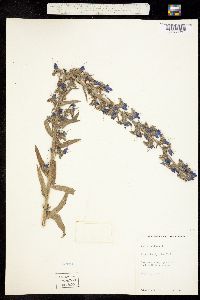Echium vulgare
|
|
|
|
Family: Boraginaceae
Common Viper's-Bugloss, more...blueweed, common echium, common viper's bugloss
|
Biennial herb 30 cm - 0.9 m tall Stem: arising from a stout taproot, erect, covered with 2 - 3 mm long, rough, coarse, stiff hairs often with swollen (pustulate) bases. Inflorescence: terminal, erect, elongate, wand-like to somewhat pyramid-shaped, with numerous, very rough-hairy, alternate, lateral, short, slightly curved branches from upper leaf axils and bracts. The individual flowers along these short inflorescence branches are almost stalkless and very tightly arranged. Flowers: numerous, bright blue, 1.2 - 2.2 cm tall, bilaterally symmetric, funnel-shaped, with two upper lobes longest, then the lateral two, and the basal lobe the shortest. Sepals: five, narrowly lance-shaped to linear, and covered with swollen-based bristly hairs. Petals: five, but fused for most of their length into a fairly hairy, funnel-shaped tube with open throat, then separating into five, somewhat spreading, shallow, rounded lobes. The two upper lobes are the longest and point upward, the central basal lobes is shortest, and the two lateral lobes are intermediate. Stamens: five, filaments slender, at least four very long and much exceeding petals, and the fifth is shorter and often barely to scarcely exceeding petals. Pistil: with one, four-lobed, superior ovary; a single, long, slender, hairy, style which divides into two, 0.5 - 1.5 mm long tips that greatly extend beyond the petals. Fruit: a cluster of four, rough nutlets attached to a flat base. Basal leaves: somewhat stalked, 6 - 25 cm long, 0.5 - 3 cm wide, inversely lance-shaped, non-toothed, with obscure lateral veins, and bristly with swollen-based hairs. Stem leaves: alternate, very short-stalked becoming stalkless, gradually reducing in size, linear to lance-shaped, non-toothed, with obscure lateral veins, and covered with spreading slender hairs which may have slightly swollen bases. Similar species: Echium vulgare is somewhat similar to Borago officinalis because of the harsh bristly hairs, but the flowers of B. officinalis are clearly radially symmetric with dramatically reflexed, large, pointed petal lobes; the very large anthers converge into a central cone well beyond the petals; and the inflorescence is more of an open branching cluster at the top of the stem with the flowers on longer individual stalks. This species may be confused with Anchusa officinalis, Symphytum officinale, S. asperum, or even the two varieties of Onosmodium bejariense, except all four of those species have radially symmetric, more tightly closed flowers with short stamens that do not extend beyond the petals. In addition, none of those taxa have bright blue flowers. Flowering: June to October Habitat and ecology: Native to southern Europe, commonly found in waste places, especially along railroad ballast and gravely areas like parking lots or trail edges. Occurence in the Chicago region: non-native Author: The Field Museum Erect, taprooted biennial 3-8 dm, rough-hairy especially above; basal lvs ±oblanceolate, 6-25 cm (petiole included) נ0.5-3 cm, the cauline progressively smaller, becoming sessile; helicoid cymes numerous and often short, ±aggregated into a pyramidal or elongate, often virgate infl; cor bright blue (pink or white), 12-20 mm; 4 filaments long-exsert, the fifth barely or scarcely so; style hairy; 2n=16, 32. Native of s. Europe, now a common weed in waste places, roadsides, and meadows in our range. June-Oct. Gleason, Henry A. & Cronquist, Arthur J. 1991. Manual of vascular plants of northeastern United States and adjacent Canada. lxxv + 910 pp. ©The New York Botanical Garden. All rights reserved. Used by permission. From Flora of Indiana (1940) by Charles C. Deam This species has been reported from five counties besides those shown on the map. It prefers sandy soil and is found mostly in fallow fields, along roadsides and railroads, and sometimes in open woods and woods pastures. In 1920 I noted a five-acre field of it in Lagrange County where it was so abundant that on June 21, when it was in flower, the whole field presented a sky blue appearance. I observed this field in later years and the owner had been able to exterminate it entirely. It has become well established in Lagrange County and is found in many places, especially in the vicinity of Mongo and Brushy Prairie. I cultivated this plant one year and the largest one stood 28 inches high, and had 22 branches, the longest of which was 42 inches long. Needless to say I did not permit it to mature seed. ...... Indiana Coefficient of Conservatism: C = null, non-native Wetland Indicator Status: n/a |




















































































